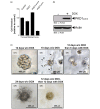Protein kinase D1 regulates matrix metalloproteinase expression and inhibits breast cancer cell invasion
- PMID: 19243594
- PMCID: PMC2687718
- DOI: 10.1186/bcr2232
Protein kinase D1 regulates matrix metalloproteinase expression and inhibits breast cancer cell invasion
Abstract
Introduction: The biological and molecular events that regulate the invasiveness of breast tumour cells need to be further revealed to develop effective therapies that stop breast cancer from expanding and metastasising.
Methods: Human tissue samples of invasive breast cancer and normal breast, as well as breast cancer cell lines, were evaluated for protein kinase D (PKD) expression, to test if altered expression could serve as a marker for invasive breast cancer. We further utilised specific PKD1-shRNA and a system to inducibly-express PKD1 to analyse the role of PKD1 in the invasive behaviour of breast cancer cell lines in two-dimensional (2D) and three-dimensional (3D) culture. Invasive behaviour in breast cancer cell lines has been linked to matrix metalloproteinases (MMPs), so we also determined if PKD1 regulates the expression and activity of these enzymes.
Results: We found that the serine/threonine kinase, PKD1, is highly expressed in ductal epithelial cells of normal human breast tissue, but is reduced in its expression in more than 95% of all analysed samples of human invasive breast tumours. Additionally, PKD1 is not expressed in highly invasive breast cancer cell lines, whereas non-invasive or very low-invasive breast cancer cell lines express PKD1. Our results further implicate that in MDA-MB-231 cells PKD1 expression is blocked by epigenetic silencing via DNA methylation. The re-expression of constitutively-active PKD1 in MDA-MB-231 cells drastically reduced their ability to invade in 2D and 3D cell culture. Moreover, MCF-7 cells acquired the ability to invade in 2D and 3D cell culture when PKD1 expression was knocked-down by shRNA. PKD1 also regulated the expression of breast cancer cell MMPs, MMP-2, MMP-7, MMP-9, MMP-10, MMP-11, MMP-13, MMP-14 and MMP-15, providing a potential mechanism for PKD1 mediation of the invasive phenotype.
Conclusions: Our results identify decreased expression of the PKD1 as a marker for invasive breast cancer. They further suggest that the loss of PKD1 expression increases the malignant potential of breast cancer cells. This may be due to the function of PKD1 as a negative regulator of MMP expression. Our data suggest re-expression of PKD1 as a potential therapeutic strategy.
Figures





References
-
- Endo K, Oki E, Biedermann V, Kojima H, Yoshida K, Johannes FJ, Kufe D, Datta R. Proteolytic cleavage and activation of protein kinase C μ by caspase-3 in the apoptotic response of cells to 1-beta-D-arabinofuranosylcytosine and other genotoxic agents. J Biol Chem. 2000;275:18476–18481. doi: 10.1074/jbc.M002266200. - DOI - PubMed
Publication types
MeSH terms
Substances
Grants and funding
LinkOut - more resources
Full Text Sources
Other Literature Sources
Medical
Miscellaneous

